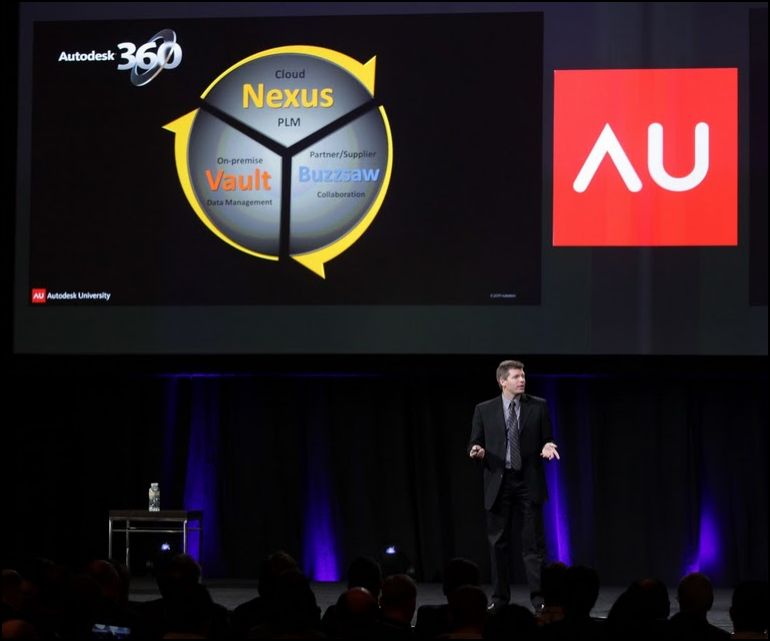Autodesk 360 is a cloud-based suite for product lifecycle management that represents a new strategic direction and a significant about-face.
 Last week Autodesk introduced a new product lifecycle management (PLM) suite called Autodesk 360; it will ship in the first half of 2012. Autodesk is tapping into the cloud to deliver a new approach to PLM, which it says will enable companies “to capture and manage product information and processes to continuously improve the products they manufacture.” Autodesk is using a combination of existing products and new technology to deliver PLM, in one of the biggest about-faces in the history of design software. We think it will cause competitors to react with new cloud-based initiatives, and bring long-overdue disruptive change to PLM.
Last week Autodesk introduced a new product lifecycle management (PLM) suite called Autodesk 360; it will ship in the first half of 2012. Autodesk is tapping into the cloud to deliver a new approach to PLM, which it says will enable companies “to capture and manage product information and processes to continuously improve the products they manufacture.” Autodesk is using a combination of existing products and new technology to deliver PLM, in one of the biggest about-faces in the history of design software. We think it will cause competitors to react with new cloud-based initiatives, and bring long-overdue disruptive change to PLM.
A bit of history
In 2007 a video of Autodesk CEO Carl Bass was a minor hit on YouTube, as he presented a self-titled “Anti-PLM Rant” at a press event. “There are only three customers in the world who have ever had a PLM problem. One is Dassault, one is PTC, and one is UGS [now Siemens PLM Software]. All competitors. There is no company that I know of that wakes up and says ‘I have a PLM problem.’ PLM is an artifact, it is a marketing slogan, to satisfy a financial community.”
In 2010 Bass and his lieutenants started adjusting the official Autodesk stance on PLM. In an interview with blogger and software developer Deelip Menezes, Bass said things had changed since 2007. “I think people have had a more pragmatic approach to PLM. You can now find working implementations of PLM systems. I think one of the problems with PLM when used in the press is that it is not a very clear term. People mean different things.”

Putting an end to PLM confusion
Last week at Autodesk University the company set about to not only introduce Autodesk 360 but to also set straight the misconceptions and confusion it says exists regarding PLM. “Our approach to PLM is a sharp contrast to the decades-old technology in the market today,” said Robert “Buzz” Kross, senior vice president, Manufacturing Industry Group at Autodesk.
Most PLM-specific analysts and third-party implementation vendors define PLM in the broadest possible terms, as all technology used to create products including CAD. Most end users mistake PLM as PDM, and use the terms interchangeably. The Autodesk definition—which got most of the press and business analysts in the room nodding in agreement—is that PLM should be defined as PDM plus software for managing processes.
In the 1990s and 2000s, enterprise-class manufacturers customers invested heavily in enterprise resource planning (ERP) software, primarily from SAP and Oracle. Companies that did invest in PLM were the ones able to spend millions of dollars to deploy the software to thousands of users; to the vast majority of smaller manufacturers, PLM was seen as an unobtainable extravagance. Most turned to homegrown alternatives using Microsoft Excel or SharePoint, or used project management solutions designed for real estate asset management. It is such deployments that Autodesk sees as its initial competitors.
Nexus will initially ship with five modules:
- New Product Development
- Process and Program Management
- Quality and Compliance
- Supplier/Partner Management
- Maintenance and Service.
Responding to perceptions
In doing its homework before developing Nexus and Autodesk 360, the company commissioned a survey of attitudes among potential customers who do not currently use Autodesk products. The top five reasons cited for not realizing true value in PLM were (in order):
- Total cost (new hardware plus software)
- Software costs;
- Time to Return on Investment
- The amount of internal and external process change required
- System integration issues.
A full three-quarters of those surveyed said they were considering cloud technology for both economies of scale and strategic benefits.
Autodesk said the survey results led them to focus on five key elements:
- PLM is much more than engineering plus PDM.
- PDM and CAD should be tightly coupled.
- PDM and PLM users are NOT the same people; they should not use the same tool.
- Users demand easy ubiquitous access. They want their business software to work like their personal software; they want apps that work like Facebook.
- Uses want rapid deployment that works with their existing practices.
On a user-interface level, Autodesk is aiming to provide:
- A contemporary user experience;
- Browser-based ubiquitous access;
- Instant On;
- Pre-installed Apps that deliver value in days, not weeks or months
- “Insanely configurable.”
Autodesk 360 is a three-legged PLM stool, with two legs already in place. For CAD data management (aka product data management, PDM) Autodesk has Vault, a popular PDM product that customers deploy on local servers. For supplier collaboration Autodesk has the cloud-based Buzzsaw, which it has sold into AEC for years; modifications are coming to better support product development. The new leg is Nexus, a cloud-based solution that will become the anchor technology for Autodesk 360. It will ship with what the company says will be an intuitive way to view business information, collaborate, manage and share data throughout product lifecycles, while integrating with existing systems and software.
Not business as usual
The key differentiators separating Autodesk 360 and existing PLM solutions from Siemens PLM, Dassault Systèmes, and PTC are the cloud-based deployment and the low cost of deployment and ongoing use. In a presentation to press and analysts at Autodesk University, the “typical” deployment cost of a 200-seat new PLM installation from one of the Big Three was compared with a similar deployment of Autodesk Nexus:
Vendor: Other PLM Autodesk Licenses $1,500,000 $0 Hardware $1,000,000 $0 Implementation $3,000,000 $100,000 Annual Maintenance $481,000 $400,000 Total $5,981,000 $500,000
The low up-front and ongoing costs of cloud-based solutions present a more affordable path by eliminating largely unnecessary capital expenditures and deployment costs. Autodesk will need to beef up its consulting unit, but intends in the long run to leave this side of the business to its leading VARs.
Autodesk’s entry into PLM—and Nexus in particular—has the same disruptive vibe about it as when SpaceClaim came to market in 2007. Before SpaceClaim, direct modeling was a minor player in MCAD; there were a few products with limited exposure and low growth. Within months after SpaceClaim launched, every CAD vendor either announced new technology to compete with SpaceClaim (Autodesk, Siemens PLM), bought existing direct modeling technology (PTC), or went to great pains to dismiss direct modeling (Dassault Systèmes, especially the SolidWorks division). We fully expect to see similar announcements or dismissals in the coming months. SolidWorks already has a cloud-based PDM, n!Fuze, which undoubtedly will soon have new features to make it more like Nexus.
By decoupling PDM from PLM, Autodesk is responding to a leading concern among its users, about putting the crown jewels of product intellectual property into the hands of a third party. Engineering CAD will remain local for the foreseeable future; by making locally hosted Vault part of Autodesk 360 the company takes care of IP issues and keeps CAD and PDM tightly coupled.
The initial markets will be SMB manufacturers and underserved departments in larger companies. Bass says the second wave of customers will come from the “over-served.” With his typical impish braggadocio Bass says a large automaker is prototyping Autodesk 360 as a tool “to wrap around their large legacy application, Chernobyl style; they can’t pull it out so they are wrapping it in concrete.”






